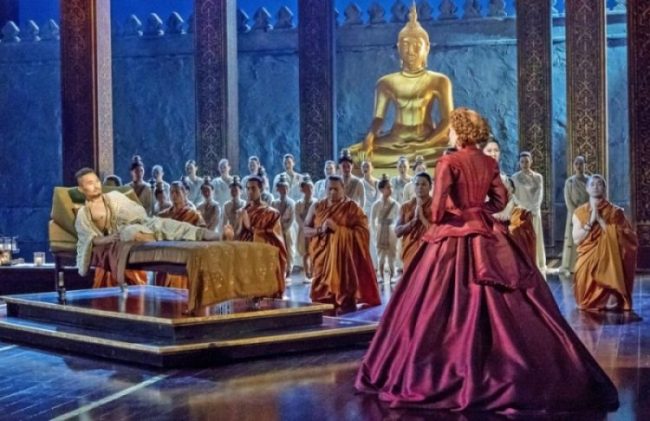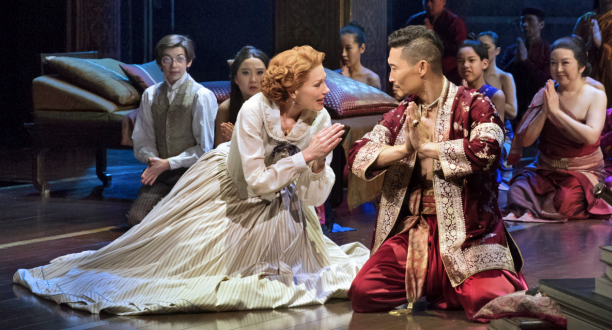
The King and I by Richard Rodgers & Oscar Hammerstein II. Lincoln Center production directed by Bartlett Sher. June 2016.
There’s a utopian notion that the original casts of Broadway shows are a paradigm to which subsequent performances can only hope to equal.
That’s not necessarily so. I attended the original The King and I and can attest that hardly any of the individual performances were as good as what we’ve seen and heard recently. Even Yul Brynner had not yet fully developed his characterization.
Faith Prince, Donna Murphy, Kelli O’Hara and others have outsung the original Gertrude Lawrence. Now Marin Mazzie is setting a new standard of excellence as Anna. Mazzie is stronger and spunkier than any who have preceded her. She speaks more forcefully, and matches this with her distinctive low and rich singing voice.
She vocally embodies the formidable woman who dared to go to a primitive country and stand up to its king. During “Hello Young Lovers”, when she sang “I’ve got a love of my own, like yours”, her repeated low G’s were the strongest and richest I’ve heard.
Visually, too, this Lincoln Center production is the best ever. Director Bartlett Sher’s production of South Pacific elicited excited gasps when, during the overture, the front of the stage rolled back to reveal an enormous orchestra in the pit, with Ted Sperling conducting. This reminded us of the large scale of American musical theater during the Rodgers & Hammerstein era.
In the new The King and I the large orchestra pit is uncovered and visible to the audience until the ship appears upstage. As the bow of the British vessel moves forward, the stage—and the ship—slide forward until they cover most of the orchestra and even protrude over the first row of the audience.
It is a metaphor for the British Empire which thrust itself into the far reaches of the globe, even into Siam which was not a crown colony (as nearby India and Singapore were). In the course of this play, we understand the fear of the king of Siam that Britain might want to take over his country, acting like a “protector.”
Sher made spectacular use of the theater’s thrust stage which is 100 feet deep and 60 feet across. (For comparison, typical Broadway houses are between 40 and 70 feet deep and about 45 feet wide.) He utilized the stage’s depth to portray the British ship moving from the distant horizon to the dock which was practically in the audience’s lap.
Sher provided specific movements for all of the disparate characters, and the ballet “The Small House of Uncle Thomas” impressively showed the presentation’s effect on those who were watching, especially the king as he realizes that the American slave master Simon of Legree represents him.
Mazzie followed Kelli O’Hara who was marvelous as Anna in her own way. Daniel Dae Kim took over the role of the king from the Japanese actor Ken Watanabe. While his appearances in comedy have been more numerous than those in musicals, he handled the singing well and made his character human.
The supporting roles are cast supremely well. Ruthie Ann Miles, as the King’s chief wife, endearingly sings “Something Wonderful,” demonstrating that she fully deserved the Tony she was awarded for the role. Ashley Park, as the slave Tuptim, shimmered in “I Have Dreamed” and “We Kiss in a Shadow.”
Michael Yeargan designed the impressive sets and Catherine Zuber the spectacular costumes. Christopher Gattelli’s stunning choreography was based on Jerome Robbins’s original.
Ted Sperling conducted the 28-piece orchestra in the original 1951 instrumentation, and restored some cuts so we even heard more than ever of R&H’s great score.
Below, Mazzie and Kim, photo by Paul Kolnik: 
Please share your thoughts with us. Address to editor@theculturalcritic.com